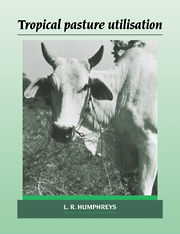Book contents
- Frontmatter
- Contents
- Acknowledgements
- List of abbreviations
- 1 Introduction
- 2 Pastures in tropical farming systems
- 3 Grazing and the environment for pasture growth
- 4 Effects of defoliation on the growth of tropical pastures
- 5 The modification of botanical composition by grazing: plant replacement and interference
- 6 The response of grazing animals to tropical pastures
- 7 Stocking rate and animal production
- 8 Continuity of forage supply: 1. The integration of different pastures
- 9 Continuity of forage supply: 2. Pasture conservation and supplementary feeding
- 10 Systems of rotational, deferred and mixed grazing
- 11 Conclusion
- References
- Index
3 - Grazing and the environment for pasture growth
Published online by Cambridge University Press: 23 September 2009
- Frontmatter
- Contents
- Acknowledgements
- List of abbreviations
- 1 Introduction
- 2 Pastures in tropical farming systems
- 3 Grazing and the environment for pasture growth
- 4 Effects of defoliation on the growth of tropical pastures
- 5 The modification of botanical composition by grazing: plant replacement and interference
- 6 The response of grazing animals to tropical pastures
- 7 Stocking rate and animal production
- 8 Continuity of forage supply: 1. The integration of different pastures
- 9 Continuity of forage supply: 2. Pasture conservation and supplementary feeding
- 10 Systems of rotational, deferred and mixed grazing
- 11 Conclusion
- References
- Index
Summary
Tropical and subtropical environments have distinctive features which control the growth and persistence of pastures. Many tropical soils are acid, of low base exchange capacity, highly weathered and leached, and subject to greater rates of breakdown of organic matter and erosion than occur in temperate regions (Sanchez & Tergas, 1979; Whiteman, 1980).
The warmer climatic conditions lead to the predominance of grasses with the C4 dicarboxylic acid photosynthetic pathway, and these have a greater photosynthetic output than the C3 grasses, especially in the high radiation conditions of the subtropics (Whiteman, 1980). The amplitude of variation in daylength between seasons is positively related to latitude, but many tropical pasture plants are sensitive in their flowering responses to small changes in photoperiod (Humphreys & Riveros, 1986). The rainfall regime varies from the truly arid desert areas of north Africa and north-west Australia, through the Köppen Aw wet and dry climates which encompass much of the savanna grasslands of Latin America and central Africa, to the truly humid equatorial regions of south-east Asia and the Amazon. The higher insolation of the tropics causes greater evapotranspiration, and acute moisture deficits can occur in soils which receive a high annual rainfall of intermittent or seasonal incidence. The combination of edaphic and climatic factors leads to a biotic environment of tropical organisms which exhibit special features with respect to the cycling of nutrients and the flow of energy between plants, animals and soil.
- Type
- Chapter
- Information
- Tropical Pasture Utilisation , pp. 26 - 45Publisher: Cambridge University PressPrint publication year: 1991

